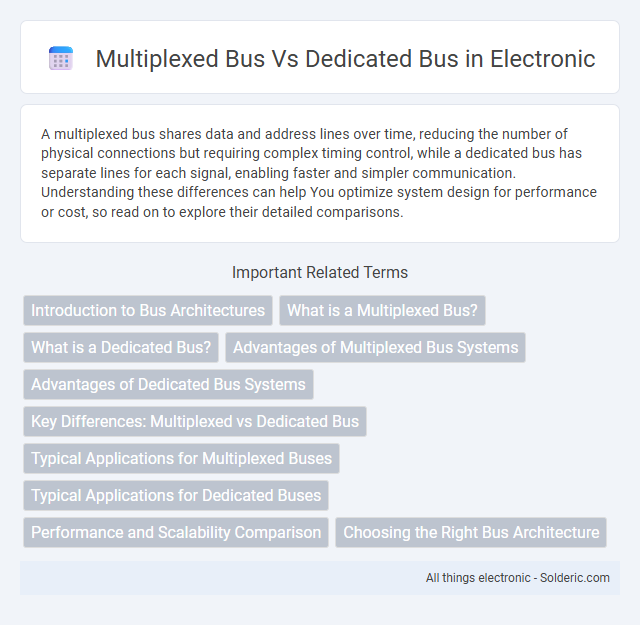A multiplexed bus shares data and address lines over time, reducing the number of physical connections but requiring complex timing control, while a dedicated bus has separate lines for each signal, enabling faster and simpler communication. Understanding these differences can help You optimize system design for performance or cost, so read on to explore their detailed comparisons.
Comparison Table
| Feature | Multiplexed Bus | Dedicated Bus |
|---|---|---|
| Bus Lines | Shared lines for multiple signals (address/data) | Separate lines for each signal type |
| Hardware Complexity | Reduced due to fewer lines | Increased due to more physical lines |
| Data Transfer Speed | Lower, due to time-multiplexing | Higher, simultaneous data transmission |
| Cost | Lower implementation cost | Higher due to more wiring |
| Signal Interference | Potentially higher, due to line sharing | Lower, dedicated lines reduce interference |
| Use Case | Resource-limited systems, cost-sensitive designs | Performance-critical systems |
Introduction to Bus Architectures
Multiplexed bus architecture combines address and data lines into a single shared bus, reducing the number of physical connections and lowering hardware costs while potentially introducing timing complexities. Dedicated bus architecture uses separate lines for address and data signals, enhancing data transfer speed and reducing latency by allowing simultaneous transmission. Your choice between multiplexed and dedicated bus depends on system requirements like cost efficiency, speed, and design complexity.
What is a Multiplexed Bus?
A multiplexed bus combines data and address signals on the same set of lines, thereby reducing the number of physical wires needed for communication between components. This design optimizes circuit board space and cost but requires timing control to separate address and data signals during operation. In contrast to a dedicated bus, which uses separate lines for address and data, a multiplexed bus improves efficiency by sharing pathways while managing signal multiplexing through control signals.
What is a Dedicated Bus?
A dedicated bus is a communication pathway that connects specific components within a system, allowing direct and exclusive data transfer without sharing bandwidth with other devices. This type of bus enhances performance by providing a stable and consistent connection, minimizing latency and potential data collisions. Understanding your system's needs for speed and reliability can help determine if a dedicated bus is the optimal choice for efficient data communication.
Advantages of Multiplexed Bus Systems
Multiplexed bus systems reduce the number of physical connections by sharing data lines for multiple signals, leading to cost savings and simpler circuit design. These systems enhance flexibility and scalability, allowing efficient data transmission across different devices without extensive wiring. You benefit from reduced electromagnetic interference and easier maintenance due to fewer interconnects in multiplexed bus architecture.
Advantages of Dedicated Bus Systems
Dedicated bus systems offer improved data transfer speed by providing a separate communication channel for each device, reducing contention and latency compared to multiplexed buses. They enhance reliability and predictability in data transmission, making them ideal for real-time applications where consistent performance is critical. The increased hardware complexity is justified by the superior isolation between signals, reducing electromagnetic interference and crosstalk.
Key Differences: Multiplexed vs Dedicated Bus
Multiplexed buses share data and address lines to reduce the number of physical connections, which optimizes hardware resources but may introduce delays due to signal multiplexing. Dedicated buses utilize separate lines for data and addressing, ensuring faster and more reliable communication at the cost of increased pin count and complexity. Understanding these key differences helps you choose the appropriate bus type based on performance requirements and hardware constraints.
Typical Applications for Multiplexed Buses
Multiplexed buses are typically used in applications where reducing the number of physical connections is essential, such as in embedded systems, microcontrollers, and portable electronic devices. These buses optimize pin usage by sharing data and address lines, making them ideal for compact systems with limited I/O capabilities. Common examples include automotive electronic control units (ECUs) and handheld devices where space and power efficiency are critical.
Typical Applications for Dedicated Buses
Dedicated buses are commonly used in high-performance computing systems where data transfer speed and reliability are critical, such as in graphics processing units (GPUs), memory modules, and high-speed input/output devices. Industrial control systems and real-time applications rely on dedicated buses to ensure consistent communication without the latency introduced by multiplexing. Your system benefits from dedicated buses in scenarios demanding fast, uninterrupted data flow and minimal congestion.
Performance and Scalability Comparison
Multiplexed buses reduce wiring complexity by sharing data lines, which can limit performance due to increased signal switching and potential bottlenecks. Dedicated buses provide higher throughput and scalability by allocating separate channels for each signal or function, minimizing latency and allowing simultaneous data transmission. Your system's performance will benefit from dedicated buses when scalability and speed are critical, despite the increased hardware complexity.
Choosing the Right Bus Architecture
Choosing the right bus architecture impacts system performance and complexity significantly; multiplexed buses reduce pin count by sharing address and data lines but may introduce latency due to sequential signal transmission. Dedicated buses provide simultaneous data and address transmission, enhancing speed and reliability at the cost of increased hardware resources. System designers must balance trade-offs between cost, speed, and scalability to select the optimal bus for applications such as embedded systems, microprocessors, or high-speed data transfers.
multiplexed bus vs dedicated bus Infographic

 solderic.com
solderic.com